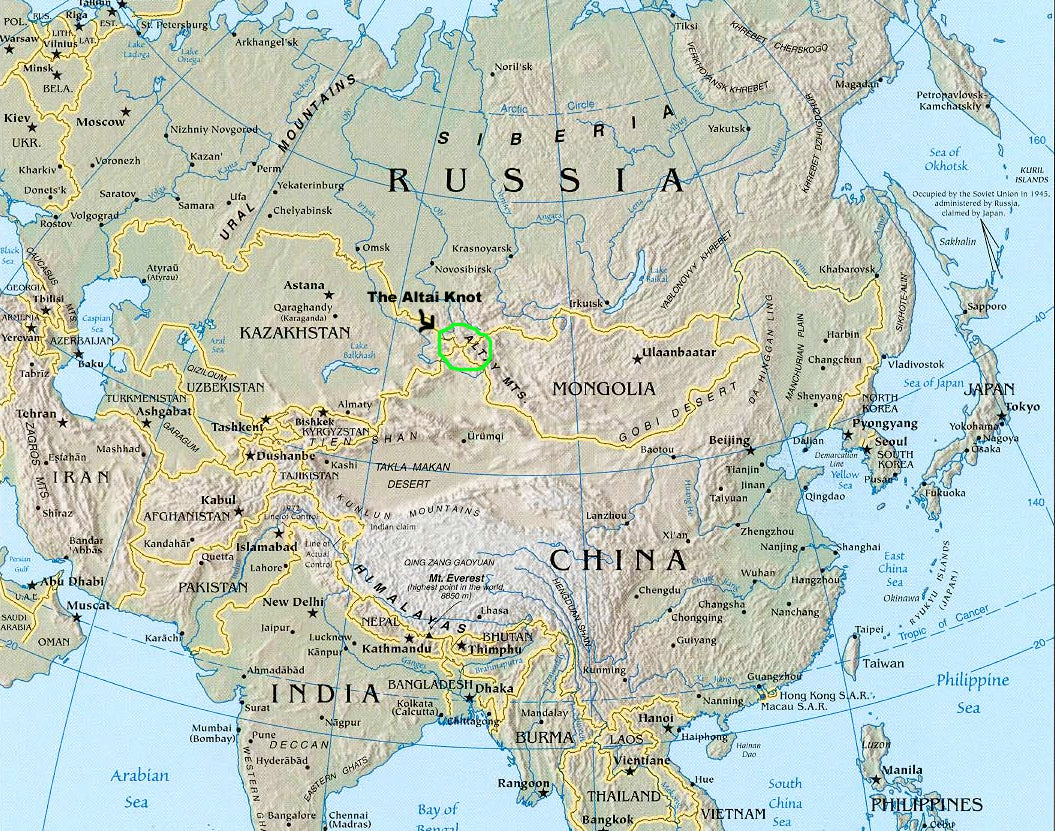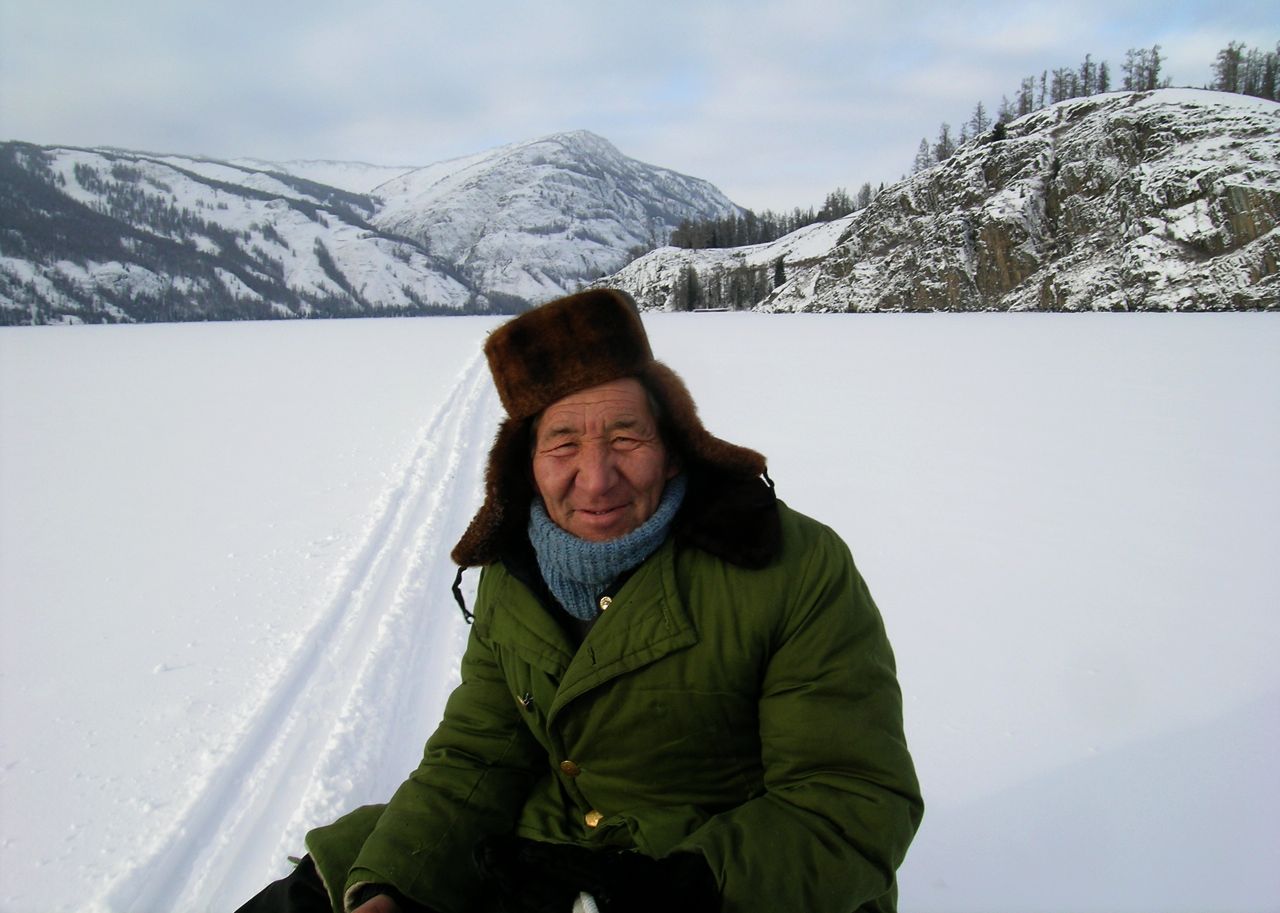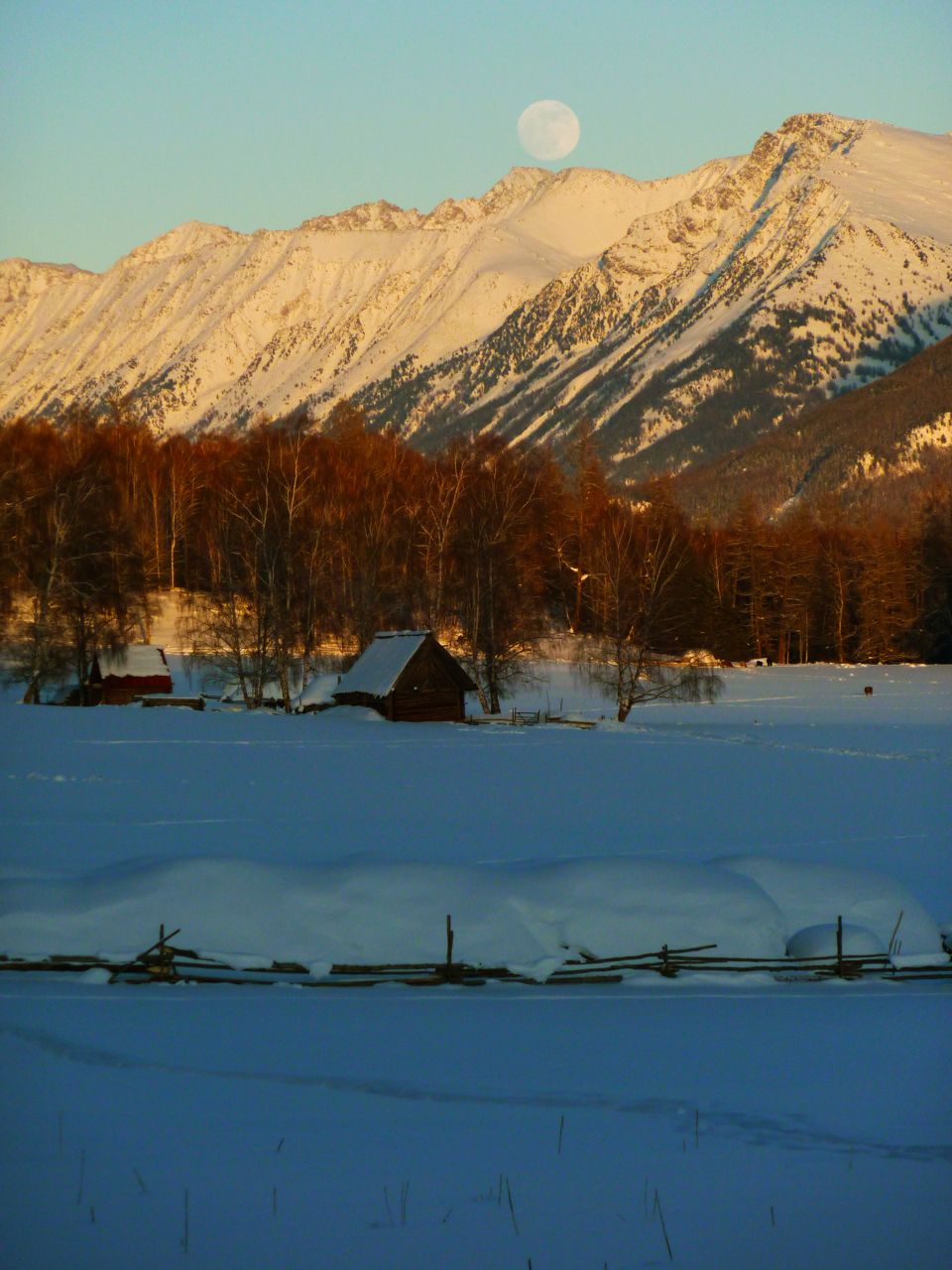Your Cart is Empty
 The area where Kazakhstan, Russia, Mongolia, and China meet is called the Altai Knot and is in the heart of the Altai Mountains. The Altai area is also dead center on the Eurasian continent.
The area where Kazakhstan, Russia, Mongolia, and China meet is called the Altai Knot and is in the heart of the Altai Mountains. The Altai area is also dead center on the Eurasian continent. We travel in the mountains on horse drawn sleds called chanas. The horses are extremely tough and cold hardy, and are the mainstay for local travel in the region. Photo by Nils Larsen
We travel in the mountains on horse drawn sleds called chanas. The horses are extremely tough and cold hardy, and are the mainstay for local travel in the region. Photo by Nils LarsenIn 2005 I [Nils Larsen] traveled with two friends, photographer Dave Waag and expedition veteran Naheed Henderson, to the Chinese Altai Mountains. This remote range is right in the center of Asia and sits at the intersection of China, Kazakhstan, Russia, and Mongolia.
 Roads are built into some areas of the mountains and as of 2009 there is an attempt to plow 2 of them that go to the main villages of Kanas and Kom. Photo by Nils Larsen
Roads are built into some areas of the mountains and as of 2009 there is an attempt to plow 2 of them that go to the main villages of Kanas and Kom. Photo by Nils LarsenDeep in these mountains, indigenous skiing survives to this day, still used as a tool for travel and hunting during the long and brutally cold winters. The skis and skiing style in the region are direct descendants from the skis used thousands of years ago, giving us a window into one of man’s most ancient – and effective – tools. The three of us spent a month in the mountains documenting skiing use and traditions as well as the day to day life of these hardy people.
Since that first trip in 2005 I have traveled to the region six more times , each trip revealing more about the ski culture in the Altais and expanding my understanding of the traditional use of skis - in the Altai but also in a broader sense too. The history is indeed rich and the skill involved in making and using these is truly impressive. My first impressions of rather crudely made skis with limited functionality have been replaced by a deep respect for the skills and versatility of these skis, so perfectly adapted to this environment over thousands of years.
 The first documentary trip was in 2005 and I was accompanied by Dave Waag, who shot stills, and Naheed Henderson, who had been in the Altai once before in 2003. Photo by Dave Wagg
The first documentary trip was in 2005 and I was accompanied by Dave Waag, who shot stills, and Naheed Henderson, who had been in the Altai once before in 2003. Photo by Dave WaggIn 2008 I completed my first film on the project - Skiing in the Shadow of Genghis Khan, TheTimeless Skiers of the Altai -As with the first trip in 2005, I thought I would have completed the project with this film. But I have returned twice more and am planning a trip for this winter as well.
 These are the first skis we saw, launching what has become a long journey of discovery for me. Later that day Aukqoiyan skied with us in a light snowfall, hooking me completely to this unique story. Photo by Dave Wagg
These are the first skis we saw, launching what has become a long journey of discovery for me. Later that day Aukqoiyan skied with us in a light snowfall, hooking me completely to this unique story. Photo by Dave WaggThe following are images collected over the last five years accompanied by brief descriptions that will give you some idea of the skis, skiers and general culture of the area.
 On our first trip to the small settlement of Tubek we found many skiers, and what turned out to be the longest skis I have seen in the Altai. Photo by Dave Wagg
On our first trip to the small settlement of Tubek we found many skiers, and what turned out to be the longest skis I have seen in the Altai. Photo by Dave WaggAt long last I am getting some information up about my ongoing project on indigenous skiing in the Altai Mountains of NW China. Since completing the film in January of 2008 I have returned once to the Altai, leaving on December 15th and returning on January 15th. The weather was cold and dry while I was there, something that has been all too common in my visits. It did start snowing two days after I left though, and ended up being quite a big winter.
 When using Chanas we hire one or more horseman - usually owners of the horses and chanas - to come with us. Doni has been on many of my trips and is a good friend and guardian while traveling. He is also an incorrigible drinker and smoker, not uncommon in the Altai. Photo by Nils Larsen
When using Chanas we hire one or more horseman - usually owners of the horses and chanas - to come with us. Doni has been on many of my trips and is a good friend and guardian while traveling. He is also an incorrigible drinker and smoker, not uncommon in the Altai. Photo by Nils LarsenDespite the dry weather I did get some excellent footage (I have now switched to HD). I also met with Shan Zhaojian, the Chinese ski historian who has been promoting the traditional skiing in NW China and has organized the local (Altai) ski races for the last few years. This year there was a first time race in Hkom that featured a hunting format. Skiers raced pulling a skin sled (Suderga) and made 3 loops on a 2+ Km course. The race was also part biathalon, with racers having to hit a target with a bow and arrow on each loop.
 I have traveled to Tubek every trip as it has a lot of skiers and is a beautiful area. This last winter (2010) had the most snow of any of the trips so far and there was a lot of skis being used as a result. We had a beautiful moon while there. Photo by Nils Larsen
I have traveled to Tubek every trip as it has a lot of skiers and is a beautiful area. This last winter (2010) had the most snow of any of the trips so far and there was a lot of skis being used as a result. We had a beautiful moon while there. Photo by Nils LarsenRacing were two skiers from the film, Bater (from the Kanas area), who unforunately broke his tiak (pole) part way through so he finished back of the pack, and Tursen, who finished 6th. He was handicaped by the archery as he is missing two fingers on his pulling hand and consequently missed a target, forcing him to ski and additional penalty leg (Tursen finished 2nd in a later race in Altai City). The winner was Mulchen, a very strong skier and son of Tuntek, also in the film. A few racers traveled from Kanderghat, a small town near Altai City and the home of all the good racers from that area. The top finisher from this crew was 2nd and another placed in the top 5.
 MonkChergul traveled with me for about a week in 2010, skiing and just spending some time with us. He's a great young guy and a pretty good skier, and knows everyone in the area. Photo by Nils Larsen
MonkChergul traveled with me for about a week in 2010, skiing and just spending some time with us. He's a great young guy and a pretty good skier, and knows everyone in the area. Photo by Nils LarsenPrize money is substantial by local standards for the races, which gives added incentive to race, but there is a fierce competition amoungst the young men that gets them out training and generally skiing a lot. My initial skepticism with the races has changed, and I now see the races as a way to keep traditional skiing alive in the Altai.
 Bater was the first young guy we met in 2005 who was keen on skiing. We stayed and skied with him for a few days and I've visited him on all trips since. He is skiing here from behind his house and into the Kanas River valley. Photo by Dave Wagg
Bater was the first young guy we met in 2005 who was keen on skiing. We stayed and skied with him for a few days and I've visited him on all trips since. He is skiing here from behind his house and into the Kanas River valley. Photo by Dave WaggI had a couple of days skiing with Tursen and Ashatu (from the film) as well as a few other locals from Aukkorum, near Hkom. There was one young skier of 11 who joined us and did great, very keen despite some impressive falls in the below zero snow. The area is tucked in the mountains and has a lot of snow for the region, and seems to have a high density of skiers - perhaps all the men. On a tour we saw lots of other ski tracks as well as a cache of skis - kind of a winter camp. Tursen also pointed out a small snare, the first I had seen in the Altai, and undoubtedly used for squirrels (tien). We also had a great sighting of a large woodpecker, called Tokoldoe. SIzed about like our Pileated, it had a minimal crown and was predominantly black with a bit of white.
© Vintage Winter - No content may be used without permission.
] Amoxicillin cuo.rpnl.snowmagazin.relaxmagazin.sk.vti.vc http://mewkid.net/when-is-xuxlya/
Very nice picture. Add more pics on mountain & snowy area.
Hey Verna,
We agree and are constantly amazed at the stunning places around the world. If you are looking for a copy of this film we have them in stock and sell them here – http://www.vintagewinter.com/products/skiing-in-the-shadow-of-genghis-khan-dvd
I love reading blogs about peoples’ travel and exploration expeditions. We live ;in a huge, beautiful, very interesting world.
Where could I get a copy of your film “Skiing in the Shadow of Genghis Khan,…..”
nnwelcoxwt
November 09, 2020
Muchas gracias. ?Como puedo iniciar sesion?